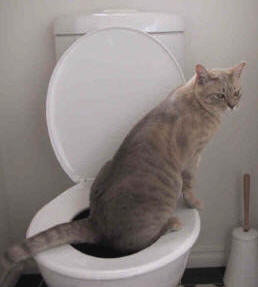Just how do you actually feel with regards to Should you flush animal waste down the toilet?

When it comes to throwing away waste, particularly animal waste, lots of people typically turn to the hassle-free choice of flushing it down the toilet. Nevertheless, this relatively easy option can have serious effects for the setting and public health. In this short article, we'll explore why flushing pet waste down the bathroom is a negative idea and supply alternative approaches for proper disposal.
Introduction
Proper waste disposal is important for maintaining environmental sustainability and public health. While it may appear safe to flush animal waste down the toilet, it can cause various concerns, both for the setting and human health.
Dangers of flushing pet waste
Environmental influence
Flushing animal waste introduces hazardous bacteria and microorganisms into waterways, which can negatively influence aquatic environments. These virus can infect water sources and damage aquatic life, interfering with delicate environments.
Public health issues
Animal waste contains hazardous bacteria such as E. coli and Salmonella, which can posture major health threats to human beings. Flushing animal waste down the bathroom can contaminate water supplies, resulting in the spread of diseases and infections.
Alternatives to flushing
Instead of flushing animal waste down the toilet, there are numerous different disposal approaches that are more environmentally friendly and hygienic.
Composting
Composting animal waste is an environmentally friendly means to deal with it. By composting, raw material is broken down right into nutrient-rich soil, which can be utilized to feed gardens and plants.
Garbage dump disposal
Getting rid of animal waste in a land fill is another choice. While not as eco-friendly as composting, it is a more secure choice to website flushing, as it protects against the contamination of water resources.
Animal waste disposal systems
There are specific family pet garbage disposal systems offered that safely and hygienically dispose of animal waste. These systems frequently use enzymes to break down waste and get rid of smells.
Actions to proper pet waste disposal
To make certain appropriate disposal of animal waste, comply with these actions:
Scooping and nabbing waste
Frequently scoop and bag pet waste using eco-friendly bags. This avoids waste from infecting the environment.
Using designated waste containers
Dispose of bagged pet waste in designated waste containers, such as garden compost containers or garbage dump bins. Avoid flushing it down the bathroom in any way expenses.
Cleaning up litter boxes and pet locations frequently
Frequently clean can and family pet areas to prevent the buildup of waste and microorganisms. Use pet-safe cleansing items to maintain health.
Benefits of appropriate disposal approaches
Taking on proper disposal techniques for pet waste uses several benefits:
Reduced environmental pollution
Proper disposal approaches decrease the risk of environmental pollution, shielding waterways and ecosystems from contamination
Lessened danger of water contamination.
By avoiding flushing animal waste down the bathroom, the danger of water contamination is dramatically lowered, guarding public health.
Enhanced hygiene and hygiene
Correct disposal methods advertise far better cleanliness and hygiene, creating a much safer environment for both humans and pets.
Final thought
To conclude, flushing pet waste down the commode is unsafe to the setting and public health. By taking on different disposal approaches and adhering to correct waste administration techniques, we can minimize the adverse effect of pet waste and contribute to a cleaner, healthier world.
What To Do With Dog Poo – The Do's And Don'ts Of Disposing Of Faeces
Dog poo bins
Some councils provide dedicated dog waste bins in popular dog-walking areas that can take dog poo that has been bagged but you can legally dispose of dog waste in any public litter bin, as long as it is securely bagged. This also applies to your wheelie bin at home.
Do not flush
Water companies do not recommend flushing dog faeces down the toilet because certain parasites can survive the water processing treatment and are potentially harmful to humans. You should also never consider flushing dog poo that has been bagged down the toilet as the bags will not break down and instead create severe blockages in the sewage system.
In the woods
The Forestry Commission promotes a ‘stick and flick’ method for dealing with waste in the woods. This means finding a stick and using it to flick any poo from off the path so that it is out of the way of other walkers. You could also bury it as long as it is not in an area where there might be livestock.
Livestock
Parasites found in dog poo can be transmitted to livestock if they inadvertently eat infected faeces that has been left on grazing land. This could result in the death of sheep or abortion in cattle so you should always make sure you pick up your dog’s waste in fields where livestock could be present.

Frequently clean can and family pet areas to prevent the buildup of waste and microorganisms. Use pet-safe cleansing items to maintain health.
Benefits of appropriate disposal approaches
Taking on proper disposal techniques for pet waste uses several benefits:
Reduced environmental pollution
Proper disposal approaches decrease the risk of environmental pollution, shielding waterways and ecosystems from contamination
Lessened danger of water contamination.
By avoiding flushing animal waste down the bathroom, the danger of water contamination is dramatically lowered, guarding public health.
Enhanced hygiene and hygiene
Correct disposal methods advertise far better cleanliness and hygiene, creating a much safer environment for both humans and pets.
Final thought
To conclude, flushing pet waste down the commode is unsafe to the setting and public health. By taking on different disposal approaches and adhering to correct waste administration techniques, we can minimize the adverse effect of pet waste and contribute to a cleaner, healthier world.
What To Do With Dog Poo – The Do's And Don'ts Of Disposing Of Faeces
Dog poo bins
Some councils provide dedicated dog waste bins in popular dog-walking areas that can take dog poo that has been bagged but you can legally dispose of dog waste in any public litter bin, as long as it is securely bagged. This also applies to your wheelie bin at home.
Do not flush
Water companies do not recommend flushing dog faeces down the toilet because certain parasites can survive the water processing treatment and are potentially harmful to humans. You should also never consider flushing dog poo that has been bagged down the toilet as the bags will not break down and instead create severe blockages in the sewage system.
In the woods
The Forestry Commission promotes a ‘stick and flick’ method for dealing with waste in the woods. This means finding a stick and using it to flick any poo from off the path so that it is out of the way of other walkers. You could also bury it as long as it is not in an area where there might be livestock.
Livestock
Parasites found in dog poo can be transmitted to livestock if they inadvertently eat infected faeces that has been left on grazing land. This could result in the death of sheep or abortion in cattle so you should always make sure you pick up your dog’s waste in fields where livestock could be present.

Do you really like more info about 10 Things You Should Never Flush Down The Toilet? Write a review directly below. We will be delighted to see your reactions about this blog entry. Hoping to see you back again in the near future. If you enjoyed reading our blog entry plz remember to share it. Thank you for taking the time to read it.
Call Today